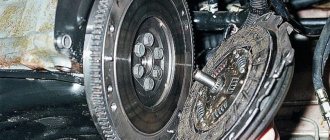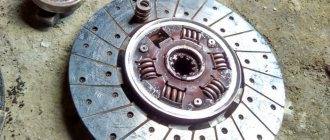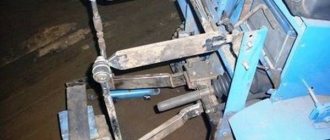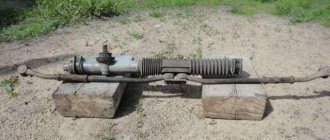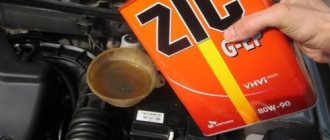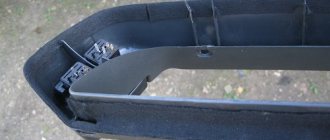The clutch plays the role of a link in a car between the transmission and the engine. This element of the internal combustion engine takes on the “impact” and all the loads that arise when transmitting torque from the engine to the gearbox. Therefore, the clutch can be conditionally classified as consumables, since it wears out quite often and requires immediate replacement. It is impossible to influence the wear of the clutch, unless you manage to change gears without its participation, although in this case it will not go unnoticed in relation to other parts of the engine.
VAZ 2110 clutch: main components and signs of malfunction
The VAZ 2110 single-disk clutch has a central pressure spring, the drive operates by means of a cable, the casing is attached to the flywheel and to the pressure plate. In short, the following elements can be distinguished:
- a crankcase with a cover and support planes, through which the clutch assembly is attached to the frame;
- casing;
- pressure and driven disks, flywheel and release fork;
- release bearing that disengages the clutch;
- cable wire going to the pedal.
As for breakdowns, the main malfunctions of the VAZ 2110 clutch are associated with its wear. However, there are many other reasons for clutch failure:
- drives the VAZ 2110 clutch, that is, there is deformation of the driven disc, breakage of the friction linings, deformation of the pressure plate, problems with the cable, etc.;
- incomplete engagement of the clutch (slippage) - burning or wear of the friction linings, the appearance of oil deposits on the surface of the discs and flywheel, jamming of the drive, etc.;
- when the clutch is working normally, jerking is observed - jamming in the drive, damage or deformation of the pressure plate, etc.;
- when turning off, the appearance of noise is noticeable - the shutdown bearing is coming out of position;
One way or another, if the clutch is faulty, the driver cannot control the car normally, gears are difficult to shift, the clutch slips, traction is lost, etc. The solution is to replace individual components or the entire assembly as a whole.
By the way, if the clutch is not very worn out, replacing only the failed components in some cases allows you to save significantly. For example, installing a clutch disc will cost less than replacing the clutch basket and disc assembly. As a rule, after troubleshooting, only worn parts of the VAZ 2110 clutch are often replaced (for example, only the VAZ clutch disc or release bearing is replaced).
However, if the condition of the unit leaves much to be desired, a complex failure of its main components is noted (VAZ clutch basket, release bearing, driven pulley, etc.), then this clearly indicates that it is better to replace the clutch completely. It turns out that everything will directly depend on the state of the node.
- As for the selection of clutches, today the market offers both original parts and an alternative to domestic kits (imported clutch kits). As practice shows, when choosing a VAZ 2110 clutch, price plays the last role, since it is important to purchase a high-quality solution.
In fact, the top five kits are:
- Kraft Tech (Turkey) – parts are able to cool well and remove wear products on their own;
- LUK (Germany) - has the property of damping vibrations, which maximizes comfort;
- Valeo (France) – high reliability, softness and wear resistance;
- Sachs (Germany) - thanks to production technology, withstands heavy loads in various operating conditions;
- VIS (VazInterService) is a popular domestic solution that is not inferior to imported analogues in a number of indicators.
How it works and what it consists of
The VAZ 2110 has a single-plate clutch with a central pressure spring. The drive operates via a cable. The casing is attached simultaneously to the pressure plate and flywheel. The design also provides for a driven disk.
The factory clutch system for the VAZ 2110 is called VIS. Many people complain about it because it doesn’t work very effectively, although others are sure that there is no more worthy alternative for the “ten”. So opinions differ on this matter.
The main components of the system include:
- casing;
- Crankcase with a cover and supporting planes with which the unit is attached to the frame;
- Driven and pressure plate;
- Release bearing. It disengages the clutch;
- Flywheel;
- Shutdown plug;
- The cable wire that goes to the pedal (far left in the car interior).
Causes of clutch disc wear
Wear of the mechanism in question is a completely normal phenomenon that occurs sooner or later. But sometimes it happens that the situation is strongly tilted in favor of “early”. Let's try to understand the reasons for the accelerated wear of the friction disc:
- Frequently holding the car on the verge of starting. For example, when you are stuck in a traffic jam, you constantly move without releasing the left pedal all the way.
- Off-road driving. In order not to stall, it is necessary to regulate the speed of rotation of the wheels with the left pedal.
- Sharp gear changes and aggressive driving style. It's no secret that this leads to increased wear of all machine parts.
- Low quality of parts - by saving on spare parts, you have every chance to repeat the replacement procedure in the near future.
The most interesting thing is that the cause of wear can be an incorrect setting of the driver’s seat, in which the left foot regularly holds the pedal in the pressed position.
Signs of clutch wear
We indicated the main sign of wear on the VAZ 2110 clutch at the beginning of the article - disc slippage during acceleration. This symptom begins to appear in the last gears, since the mechanical resistance during acceleration at such speeds is much higher. The more the disk is worn, the lower the speed it becomes noticeable. In addition, a specific smell appears from rubbing against the basket.
Another no less accurate indicator of friction disc wear is the position of the left pedal when starting off. If the car starts to move at the moment when the left pedal is in the upper position, then most likely the mechanism will not “live” long. But this may also be due to incorrect clutch pedal adjustment.
In case of unnatural wear of the disc (fractures, cracks, chips), the car may twitch when moving away, and characteristic sounds may be heard from under the hood.
When is it necessary to install a new clutch on a VAZ 2110 car and why?
Restoring a car on your own has always required not only some effort, but also financial investment. It is precisely because of the last factor that car owners try to carry out repairs themselves, thus saving on payments to service station workers. Clutch repair, of course, is not comparable in labor intensity to changing the working cylinder , but even if you have basic skills, it is quite doable in a garage.
To prevent replacing a VAZ 2110 clutch disc from becoming a waste of time and money, it’s a good idea to find out the symptoms indicating the need for repairs; experienced car enthusiasts already know them, but it will be useful for beginners:
- Loss of engine power.
- Vibrations when pressed or a “cotton” pedal.
- Switching on gears occurs with slipping or is accompanied by crunching and jerking.
- Spontaneous gear shutdown.
- Difficulty switching on speeds.
- Friction lining smell.
It is important to clearly identify the source of the problem; for example, a “stuck” pedal may also indicate that drive cable . Experienced motorists regularly check the condition of the friction mechanism every 80,000 km so that the installation of the VAZ 2110 clutch is fully justified.
Clutch diagnostics on a VAZ-2110
The VAZ-2110 received the mechanism from the eight and nine virtually unchanged, only the downforce was adjusted, which corresponds to the engine torque.
Clutch diagram.
Nevertheless, every clutch has its time. The resource of the unit greatly depends on the driving style and operating conditions. And besides, from the kit manufacturer. By the way, it is not at all necessary to change the clutch assembly due to a failed driven disk or release bearing; it is expensive.
But replacing any element of the mechanism, as well as the entire clutch, at a service station will cost at least 3-5 thousand rubles , not counting the cost of materials. Therefore, it makes sense to do the repairs yourself. This is not the simplest operation, but it is quite accessible even for a novice driver.
Clutch kit: basket, disc, bearing and mandrel.
Main problems
The clutch mechanism contains important parts, the repair of which must be treated with great responsibility. It consists of:
- pressure plate – clutch basket;
- disengaging clutch with a bearing, in other words, a release bearing.
It becomes possible to simplify the repair and replacement of the clutch basket, this also applies to changing the release bearing, since today in the package you can find clutch parts supplied by the machine manufacturer. Thus, there is no need to change parts separately. Based on car maintenance technology, it is recommended to change them completely.
Signs of a clutch problem include a situation in which the car does not gain enough power. Noise may be heard when depressing the clutch pedal. The car may also jerk and skid when starting off. Most often, certain problems in the clutch appear due to wear of parts. When it comes to novice drivers, the picture is different. As a rule, the driver himself is to blame for choosing the driving mode illiterately. There is often a situation where car owners compete with each other, starting quickly from a traffic light.
Choice
If you plan to simply replace the disk, purchasing a completely new node does not make sense from a financial point of view. But when the old clutch leaves much to be desired due to the quality of its work, it’s worth thinking about completely replacing the unit.
Today the market is represented by an extensive list of alternatives made in Europe and China. We strongly do not recommend using Chinese spare parts, but European analogues should be considered as a replacement for VIS.
According to a study conducted among VAZ 2110 owners, the five best kits for the domestic “ten” were determined:
- Kraft Tech.
- LUK.
- Valeo.
- Sachs.
- VIS.
As we have already noted, VIS is installed as standard and works quite well. An important advantage compared to European counterparts is financial accessibility. But if your wallet allows it, replace the old clutch with a better and more expensive one.
In defense of the VIS system, we note that repairs often require simply adjusting the pedal and tightening the cable. And if you are going to completely change VIS to VIS, it will not cost you a pretty penny.
Which VAZ 2110 clutch is better?
This question is asked by every VAZ 2110 owner when he is faced with the need to choose a mechanism. Below are the results of reviews of devices by experts in the Russian automotive market. It is also worth noting that during the research process, the most popular manufacturers among domestic motorists were considered.
- Krafttek. The kit does not include a bearing, so you will have to buy it additionally, and there is also no quality mark. The basket is equipped with 18 petals and the driven shaft (Y 3200A B0206) has 4 springs. This mechanism is recommended for use in the VAZ 2110.
- German manufacturer Luke (Lamellen und Kupplungsbau). The set is complete, you don't have to buy anything else. The packaging contains the MT14 quality mark. In addition, the driven shaft is marked with markings for proper installation. The element basket also has 18 petals, and the driven shaft is equipped with 6 springs. It is also worth noting that the basket side is marked on the shaft.
- Valeo, manufacturer France. A complete set, you don’t have to buy anything extra. Moreover, this clutch comes with a lubricating fluid for the mechanism, as well as a CD with installation instructions. There are 18 petals in the basket.
- Russian. The kit does not include driven and pressure pulleys, as well as a release bearing. Nevertheless, the product received the AYA70 quality mark. There are 12 petals in the basket, and 6 springs on the driven shaft. The product has been approved for installation in the VAZ 2110.
- Pilenga, country of origin unknown. The kit does not include a pressure pulley and a release bearing, so if you decide to replace the mechanism completely, then these components will need to be purchased. There are 18 petals in the basket. There are 8 springs on the driven shaft. There are no approval marks on the packaging.
Actually, any of the clutches listed above is suitable for VAZ 2110 cars. For example, the Luke cannot produce maximum torque, so engine power will be reduced when driving. Krafttek is a fairly reliable, time-tested mechanism, although you will have to purchase some additional elements to install it.
It is worth noting that this unit also has many positive reviews on the Internet from other motorists. But keep in mind that if the package for this mechanism does not contain lubricating fluid and a CD with installation instructions, then this is a fake. Having installed such a device, be prepared for the fact that it may fail after 5 thousand kilometers.
What you need to know
The release bearing is not the weakest link in the clutch system, but for some reason it is the one that causes problems and troubles.
Some car owners have gotten used to the whistle and simply ignore it. But this cannot continue for long, since untimely solution to the problem can lead to even more complex and expensive repairs. If the situation gets worse, then a simple replacement will not be enough for you.
The clutch serves to act on the leaf spring of the clutch basket. It is also called diaphragm, so don't be confused if you hear this designation. Due to this impact, the driven disk is disconnected from the flywheel and the pressure plate of the basket. This disengages the clutch.
If the squeezer is faulty, this can lead to various consequences:
- The clutch fork will be damaged;
- The integrity of the clutch spring petals will be compromised;
- The guide bushings are deformed.
In order not to pay twice, or even three times, promptly react to the appearance of a whistle in the clutch and try to quickly take action.
Important features of clutch assembly
Proper assembly of this spare part at home involves taking into account some important nuances:
When you are centering a disk, you need to use a mandrel specially designed for this or equip yourself with a primary shaft. This method will allow you to place the gearbox in place. Once the job of placing the shaft spline into the clutch splines is completed, the input shaft can be easily pulled out. The cable is attached to the fork and slightly loosened. Subsequent adjustments are carried out only when the clutch assembly has come to an end.
Don't forget to secure the control levers and traction lever to the panel. Tighten the fasteners well to prevent them from coming loose on the road. Be sure to connect the battery and, finally, connect the filter housing that cleans the air flow.
How to change the clutch basket
Clutch basket for VAZ 21101
As noted above, garage conditions, a jack and several support blocks are quite suitable for changing the clutch basket. Ideally, it is better to use a lift. Before you begin work, you need to familiarize yourself with the repair manual for your car, the mandatory repair methods, as well as car maintenance. So:
- You need to find a catalog of parts, since many of them may be missing or some of them will be superfluous.
- Immediately before removing the clutch from the gearbox, you need to mark how the rotating parts are placed so that there is no vibration during reassembly.
Clutch basket for VAZ 2110
- The shift lever is removed from inside the car.
- There is now clear access to disconnect the gearbox.
- The bolts that secure the basket to the flywheel are unscrewed. When turning the flywheel, you need to hold it with a mounting tool.
- The driven disk and basket are dismantled.
- The clutch release clutch with the bearing is removed.
- During the repair process, you need to inspect the clutch fork, or rather its condition. Also inspect other parts for wear.
- The release bearing is pressed out of the clutch; of course, this is labor-intensive work. Next, replace the clutch bearing. As a rule, it is better to use lubricants recommended by the manufacturer to lubricate parts.
Note! The parts must be thoroughly washed in kerosene, and they must be fault-detected. Do not install clutch elements that are already damaged.
All parts must be cleaned of obsolete lubricants and then lubricated with a new compound. At the end of the work, the treated elements are mounted in the opposite order to disassembly. The removed gearbox with clutch is installed in its place.
Note! It is recommended to pay special attention to the tightening of the bolts; in this case, it is necessary to clarify the parameters of such tightening.
Changing the clutch basket is not as difficult as it seems at first glance; it is enough to have minimal knowledge, skills and the ability to use special devices. To perform the work correctly, it is important to follow the recommendations. Today, with the help of videos and photos, you can repair or change important clutch elements with your own hands. Also, an important role is played by correctly selected step-by-step instructions, without which it is difficult or impossible to complete this or that process. To avoid having to redo the work again, you need to purchase only high-quality spare parts, the price of which directly depends on the manufacturer.
Preparatory stage
Before changing the clutch on a VAZ 2110, you need to prepare a place for repairs and tools. For this process, the most suitable solutions are: a car lift or an inspection hole. If there are no such conditions, due to a hopeless situation, it is possible to replace the clutch with a 2110 in “Spartan conditions”. It is enough to find a flat surface area in a garage box, a parking space or in the yard.
It is more practical for a car owner to ask in advance how much new clutch parts will cost to replace a VAZ 2110. This will help prepare the necessary budget. The price of spare parts varies and depends on the manufacturer. Among manufacturers of quality parts, the leaders are: Sachs, Luk, Valeo and Krafttech. These spare parts are guaranteed to fit the vehicle and have a long service life. Poor quality parts may not fit at all or may fail in the first days after repair.
Step by step instructions
So, if you decide to change the clutch device yourself, but do not want to bother with dismantling the gearbox, then we will look at the replacement process without removing the box. Let's get started:
- Unscrew the screws securing the left wheel of your car and place the front part of the VAZ 2110 on a jack. To protect yourself, place bricks under the car body. Also place wheel chocks under the rear wheels.
- Next, you need to completely remove the wheel and unscrew a few mounting screws that hold the ball joint in place.
- After removing the wheels, open the hood and disconnect the battery. To do this, it will be enough to remove the negative terminal from the battery. This is done in order to prevent short circuits during repair work.
- Now you need to remove the air filter element housing. This must be done in order to gain access to the screws with which the gearbox is attached to the internal combustion engine.
- If there is engine protection, then let's start removing it. Unscrew all the screws around the perimeter of the motor protection and remove it.
- Remove the long screw that secures the anti-roll bar.
- Now let's get down to one of the most crucial moments in this work process. If you decide not to dismantle the transmission, you will still need to move the unit to the side. In order for the unit to move freely, it is necessary to remove the left mudguard. After this, unscrew all the ball joint bolts.
- Next, move the left strut behind the wheel drive. Otherwise, you will not be able to move the gearbox.
- After this you will need to disconnect two connectors from the transmission. To the right of the unit there is a plate responsible for fastening the jet thrust. By the way, the other part of the plate is located at the gear shift lever. Visually remember the location of the jet thrust fastener, otherwise you will have to sweat later to adjust the unit selector to the working position.
- With the connectors disconnected and the torque rod removed, the transmission is essentially freed from its main mounts. Now you need to disconnect it directly from the internal combustion engine. Here, use wrenches and remove several bolts (usually no more than three) and one nut.
- Now it is necessary to dismantle the rear cushion, which, in fact, attaches the gearbox to the engine. This should be done so that the engine is not released too much, so it is better to place the internal combustion engine on a jack or on supports.
- The same must be done with the gearbox, having first moved it to the required distance. Here you may need help, since it will not be easy to move the unit and place supports under it alone. In addition, everything must be done carefully to prevent mechanical damage to the unit.
- You now have access to the clutch mechanism. Replace it, and then reassemble all parts in the reverse order. Tighten the transmission-to-engine screws securely. After replacing the clutch, you need to center the disc.
A few notes
Taking advantage of the fact that you have climbed quite deep into the inside of the car, you can carry out some additional actions so as not to return to this in the near future.
- It is advisable to change the release bearing along with the clutch;
- You also need to check the clutch paddles and the clutch basket itself. If there is significant wear, do not be lazy to replace them, otherwise in the near foreseeable future you will have to climb into the hole again;
- The driven disk must be centered
. It would be good to use a special mandrel for this purpose. If this is not available, you need to at least select a wooden round of the required size. When the basket fasteners are tightened, if the alignment is done correctly, the mandrel (or its substitute) should come out without any effort. But don’t fall out on your own.
Actually, this completes replacing the clutch on a VAZ 2110 without removing the box and draining the oil. As you can see, nothing super complicated was required, although we did have to tinker. If this is not your first time seeing the jack and keys, the whole procedure will take you no more than 2-3 hours, and even then with smoke breaks. Note: if the box had also been dismantled, it would have taken you much longer, and you might have had to spend the whole weekend fiddling with the hardware.
How to renew?
The main factor influencing clutch life is driving style. To save the disk, you need to avoid high loads. Do not start driving at high speeds (with slipping) and do not overload the vehicle itself. The last factor also applies to those who like to drive with a trailer. Remember that every kilogram from the trailer loads the gearbox and clutch components. Do not tow vehicles that exceed your curb weight. These factors directly affect the life of the clutch disc. Using a careful driving style, you can increase the capabilities of this element to 150 thousand kilometers or more. In sports driving mode and other loads, even the highest quality VAZ 2110 clutch, the price of which is quite high, will not last even 40 thousand kilometers.
Procedure for removing and replacing the clutch release fork:
1. First, after removing the gearbox, you need to remove the clutch release bearing. 2. The next step is to remove the rubber boot (number 1). You need to pry it off with a screwdriver and pull it off the clutch release fork (number 2 in the photo). If the protective rubber cover has defects (cracked, deformed, no elasticity), then replace it with a new one. 3. Using a screwdriver, pry up the plastic bushing of the fork axle, and using pliers on the inside of the clutch housing, squeeze the petals that fix it and remove this bushing. If this plastic cap is defective (no petals, cracks or other obvious signs of wear), replace it with a new one. 4. Now it’s time to remove the clutch release fork. Lift it and remove its axle from the bushing that is pressed into the clutch housing and remove the fork, removing the axle, and then the lever from the holes in the clutch housing. 5. Squeeze the ends of the fork spring retainer and remove it. If the retainer has defects (no elasticity or even broken), then replace it with a new one. 6. The plug that is responsible for turning off the drive must be replaced with a new one if it has:
- 1 – the fork lever is cracked, bent or deformed;
- 2 – the legs of the part in the area where they contact the bearing coupling also have obvious defects and signs of wear.
7. Inspect the yellow metal bushing; if it has defects, press it in and insert a new one until it stops. 8. Before installing the drive release fork back, lubricate both bushings (metal and plastic) with grease. 9. Now you can safely mount the clutch release fork back in the order of dismantling. But, pay special attention to the protrusion on the plastic bushing; it should fit into the pothole on the clutch housing, and it
Installing a new element
When you have completed the entire range of dismantling work, you can move on to the final stage - installing a new component.
- The first thing to do is check the condition of the new clutch release bearing. For some reason, many car owners forget to make sure that the bearing that replaced the old one is actually in good working order. This is easy to check. Rotate the bearing, pull it in different directions. If there is no jamming during rotation, and there is also no play, then you bought a really serviceable, good release bearing.
- Insert the new part into the coupling. This must be done so that the protruding part of the inner ring is directed towards the coupling.
- After inserting the element, secure it using the holders.
- Before inserting the new release bearing onto the bushing (guide), do not forget to lubricate it with a grease. The layer of lubricant should be thin, do not overdo it.
- Secure the coupling and bearing using a spring lock.
- Place the gearbox and other dismantled elements in their rightful places.
- The entire repair process is completed by adjusting the clutch.
We carry out the replacement without removing the gearbox
Most VAZ 2110 drivers do not pay attention to obvious signs of the clutch disc coming out. And here the advice of experienced drivers will be indispensable:
- Put the car on the parking brake.
- Start the engine.
- Depress the left pedal, then shift into fifth gear.
- Smoothly release the control lever.
The smell in the cabin, combined with problematic gear shifting and frequent jerking while driving, indicate wear on the driven disk. The reasons for the symptoms are:
- deterioration of the condition of friction linings;
- increased radial runout;
- springs are seated.
at first glance it seems like a rather painstaking process, but this is just an illusion as in fact everything is quite elementary. The most basic thing is to follow the step-by-step instructions we provide below. To work, you will need a standard set of tools, an inspection hole or a lift, and preferably the help of a second person.
A set of necessary tools
Required Tools
To replace a VAZ 2110 disk you will need the following tools:
- set of wrenches;
- set of heads;
- flat screwdriver;
- mount or amplifier pipe.
Work must be carried out with the ignition off, while in an inspection ditch or on a lift.
Step by step instructions
Clutch replacement is necessary in the following cases:
- the mechanism begins to “drive”, that is, when the engine power decreases;
- the clutch does not function at full strength and “slows down”;
- when turned on, there is an extraneous sound - clicking; jerks, etc.;
- the mechanism stops working on its own;
- There is vibration when you press the pedal.
Replacing the VAZ 2110 clutch step-by-step instructions
In order for the replacement to be made without removing the gearbox, you need to:
Unscrew the bolts holding the left wheel. Place the vehicle on a jack. Remove the wheel and unscrew the two lower ball bolts holding it together. Remove the terminal from the battery
Unfasten the DMVR, then loosen the fastening tie of the DMVR bellows and remove the air filter. Unscrew the bolt holding the starter towards the box, unscrew the first bolt holding the gearbox. Unfasten the connector from the speed sensor, then unscrew it. Disassemble the longitudinal extension together with the lever. Unscrew the lower starter fastening bolt. Unscrew the third bolt securing the gearbox. Unscrew the two bolts holding the torque rod together. Loosen the nut located on the tie rod of the gearbox control drive, remove the rod from the box. Provide the motor with support, then unscrew several nuts holding the rear cushion together. Carefully move the gearbox away from the engine and lower it to the ground. It is necessary to diagnose the vehicle from time to time, this will contribute to the long service life of the mechanism
By eliminating clutch defects in a timely manner, you will ensure a safe ride and protect yourself from sudden problems with the mechanism on the road.
It is necessary to carry out diagnostics of the vehicle from time to time, this will contribute to the long service life of the mechanism. By eliminating clutch defects in a timely manner, you will ensure a safe ride and protect yourself from sudden mechanical problems on the road.
Replacing the release bearing
The difficulty of replacing a bearing lies in the fact that it is impossible to do without dismantling the gearbox (gearbox). And in order to remove the gearbox, figuratively speaking, you need to disassemble another “half” of the car. Next, let's talk about everything in order.
Work on replacing the release valve of a VAZ 2110, that is, dismantling the car in order to get to the clutch bearing, should begin by placing the car in a pit or on a lift. After this, we dismantle, disconnect or unscrew the following components and parts:
- battery;
- air filter box with mass air flow sensor;
- clutch cable;
- upper gearbox mounting bolts and starter mounting nut.
Next, after unscrewing the left and loosening the right hub nuts, loosen the front wheel bolts and raise the car on a lift. If you do not have a lift at your disposal, you should jack up the car until its front wheels lift off the surface.
To tear them off, it is necessary, paying special attention to safety, to install supports one by one under each side of the car body.
We remove the wheels. Then, in turn: the dirt-proof apron (engine protection), loosen the fastening on the gearshift drive torque rod (before loosening the clamp, it will be useful to mark the old installation location in order to facilitate adjustment of the gearshift lever during assembly), free the gearbox from the gearshift drive rod and jet rod , after unscrewing the remaining nut, dismantle the starter, remove the left suspension arm with a brace and a ball joint. To do this, you will need to unscrew the anti-roll bar from the lever, the ball joint and all connecting fasteners of the lever.
The clutch housing cover is removed after unscrewing the three bolts securing it, drain the oil from the gearbox, disconnect the terminal from the speed sensor and the reverse light switch wire, dismantle the left drive (to ensure the immobility of the satellites in the gearbox, instead of the drive, you can insert a wooden plug, a piece of rubber hose, or simply magazine rolled into a tube according to the diameter of the hole). The right drive may not be dismantled; in this case, it will be enough to just loosen the nut on its hub, but by removing the drive, it will be much more convenient to work.
Next, you need to hang the engine (install a support under it), which will avoid distortion of the power unit and breakage of the heater hoses after removing the gearbox. Then we unscrew the nuts securing the support(s) located on the gearbox, unscrew the bolts and nut securing the clutch housing to the cylinder block and the bracket to the gearbox. All that remains is to move the gearbox away from the engine and remove it. The support installed under the engine remains until the transmission is installed in place and the nuts on the support(s) are tightened.
We proceed to replacing the release bearing of the VAZ 2110. To do this:
- We release its lock.
- Remove the release bearing assembly from the shaft and then from the holder.
- We remove the bearing itself from the coupling.
Before replacing the old bearing, check the free rotation and absence of jamming of the new release bearing. When installed, its protruding side faces the coupling. The bearing is secured with a holder and installed on the shaft, where it is secured with a spring bracket. When replacing the release valve, it is recommended to inspect the clutch basket and driven disc. Work on installing the gearbox is carried out in the reverse order.
After assembling all components and assemblies, it is necessary to check and, if necessary, adjust the operation of the VAZ 2110 clutch. Carrying out the replacement without an assistant, if you have all the necessary tools, the work will not take more than 5 hours. If the replacement takes place at a service station, the cost of the issue in terms of time will be even less.
Popular problems and their solutions
There are several characteristic faults that occur on the VAZ 2110. Let's try to understand the reasons for their occurrence, and also consider ways to solve the problem.
- The clutch drives. The reasons may be: The pedal has insufficient travel, the tension is too tight. To eliminate this, you need to adjust the drive;
- The driven disk is deformed. Only replacement will help here;
- The driven disc hub sometimes gets stuck. If so, try washing it and lubricating the input shaft splines. If the element or the shaft itself is worn out, then replace them;
- The friction linings are broken and the rivets are loose. The best solution is a complete replacement of the casing, which includes a spring and a disk;
- The pressure plate is warped or warped. Replace the linings, but first make sure that there are no deviations in the end runout of the disk;
- There were problems with the cable. Pull it up. If there is no result, replace with a new one.
- The friction linings on the driven disk often burn or wear out. There is only one solution - replacement;
- Oil has reached the surface. We have already described how to solve the problem above;


